Chinoiserie

Needle Case back (photographs from eBay)
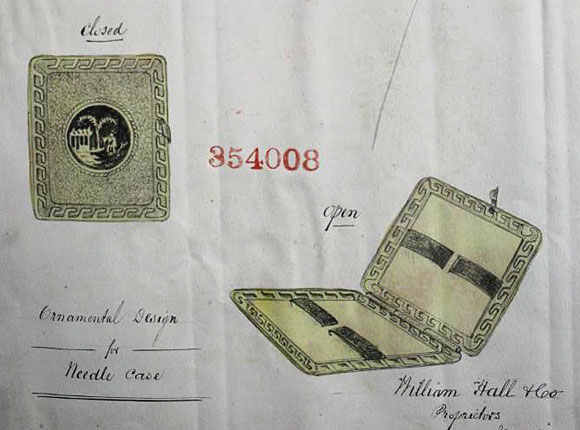
Design Representation
Design Details
Needle Case Type: |
Flat-Names |
Patent/Registered to: |
William Hall & Company - Studley |
Patent/Design Representation #: |
Ornamental Class 1: Metal: #354008 |
Patent/Design Registration Date: |
August 20, 1880 |
Location of Patent/Design Registration: |
The National Archives (TNA) - Kew, UK |
Reference #:
|
TNA Representation - BT 43/47/354008
TNA Register – BT 44/4/354008 |
Dimensions: |
4.6 x 5.3 |
Material: |
Brass |
Name Variations: |
Unmarked |
Other Variations:
|
none
|
Additional Photographs
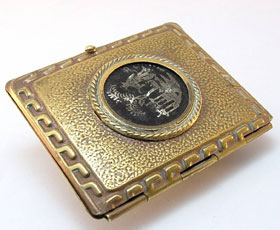
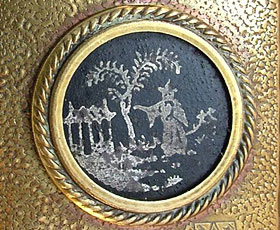
Front and center decoration detail
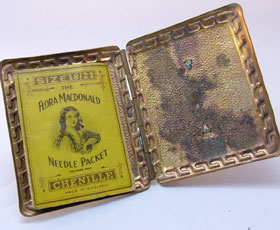
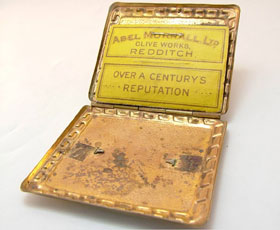
Interior details with paper needle packet (paper packet may have been added at a later date)


Catch detail (probably a replacement) and diamond registration mark detail
Facts
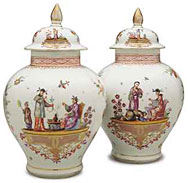
Chinoiserie refers to a style of decorative art using oriental inspired motifs and forms adapted to Western tastes. Common themes are
figures in traditional Chinese dress, landscapes, pagodas, flowers, birds, dragons and phoenixes. The style was often used on porcelain,
fabric and lacquerware but can also describe furniture and architecture. There have been recurring periods of resurgence of popularity of
Chinoiserie over the last three centuries.
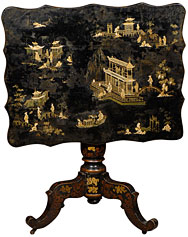
History
From the 16th century the trade of goods between China and the West began as first the Portuguese then the Dutch then the British endeavoured to
set up sea trade footholds. Prior to this, trade had been by overland caravan or through other Asian maritime ports. Though sea trade
was largely resisted by China’s Emperors, by the 17th century goods were flowing to the west. Tea, porcelain and silk were highly valued
luxury items and the popularity of oriental wares of all kinds grew. European potteries began to copy the decorative style. Chinoiserie
style décor based on oriental themes originated in France and spread through Europe and North America inspiring patterns for tiles, dishes, vases,
fabric, wallpaper and furniture and reaching a peak in the period 1750-1765. The style was often blended with other popular styles of Rococo
and Gothic. There was a revival of interest in Chinoiserie in the Victorian era. As prosperity created a growing middle class, the
demand revived but it is said that Victorian pieces were less subtle and delicate than those of earlier times and tended towards overstatement and
garishness.
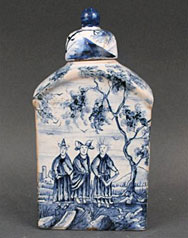
Miscellaneous
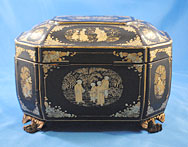
Tea was a major import from China and as popularity and availability increased so did the popularity of Chinese themed storage and servicing
wares. The tea caddy or tea storage containers is thought to be named from the Chinese unit of weight the catty or kati which is equal to
1 1/3 pounds or a little over 21 ounces. European potters like Delft copied the blue and white of Chinese export porcelain to produce
Chinoiserie caddies which were similar in appearance to ginger jars. Lockable tea boxes or chests were also common often containing more than
one metal container for tea. Instruction books on “japanning” technique for lacquer ware and books with oriental inspired artwork for copying were
available to English craftsmen by the late 1600’s.
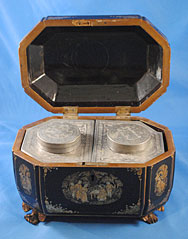
Note: Right side panel text and photos provided by Lynda Herrod.

















